Airfix 1/144 BAC 1-11
|
KIT #: |
3178 |
|
PRICE: |
HK$65 SRP |
|
DECALS: |
Two options |
|
REVIEWER: |
Richard F |
|
NOTES: |
|
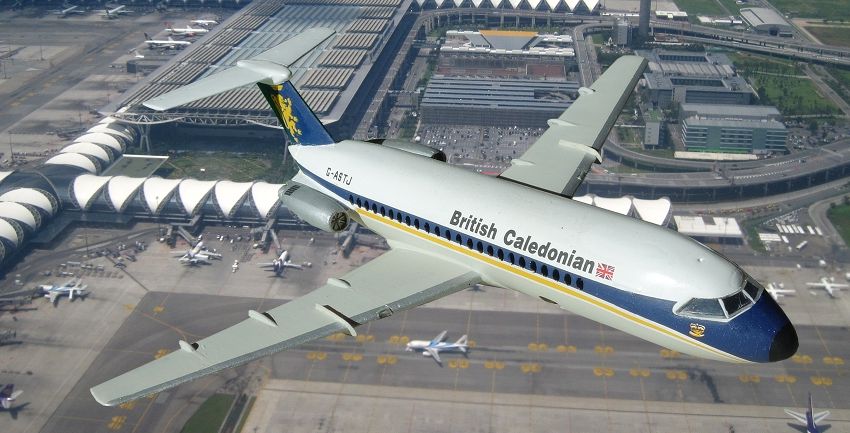
Back when I was a kid, I thought "work" was some magical place where Dad
went to do all kinds of things I could never dream of understanding. Now, of
course, I realise that in those days he was as old as I am now, and all he
was doing was putting up with the same crap I face every day at the office.
You know, dealing with idiots, the usual stuff. But one thing he did get to
do that I will truly never be able to do no matter how many meetings I sit
through or how much business jargon I listen to is to fly the British
Caledonian BAC-111s from London to Edinburgh. I remember how much he enjoyed
that back when I was a 6 year old. Might have been something to do with the
tartan-clad hostesses (yes, you could call them that in those days). So when
I saw the Airfix re-release of this plane a few years back, I snapped it up.
I started it quickly and then it languished on the infamous Shelf of Doom
for half a decade or so.
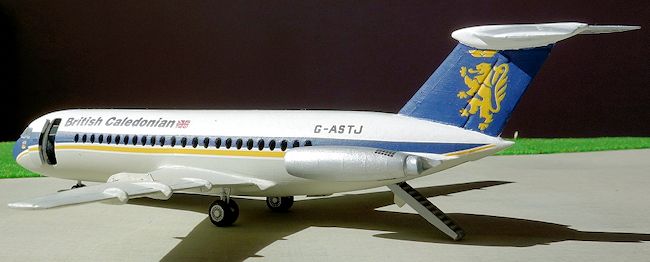 British
Caledonian was a private airline that grew from a charter operation to a
fully competitive scheduled airline in the 1970s. By 78 and 79, when I
became aware of it from the old man's business trips, it was really hitting
its stride. New routes were opening up and its investment in widebody jets
saw its profits at nearly 10 million pounds by 1980.
British
Caledonian was a private airline that grew from a charter operation to a
fully competitive scheduled airline in the 1970s. By 78 and 79, when I
became aware of it from the old man's business trips, it was really hitting
its stride. New routes were opening up and its investment in widebody jets
saw its profits at nearly 10 million pounds by 1980.
But airlines are a hell of a business. The following year it made a loss of
6 million pounds, and the 1982 Falklands War impacted its more profitable
South American routes (because Argentina denied British aircraft landing
rights in Buenos Aires, a lucrative destination for the airline). By 1984 it
was back in profit, more than 10 million pounds, even more the next year.
But 1986 hit the airline really hard. Amazingly, it was decreasing oil
prices that played a role. Most airlines would be grateful for that, but
BCal flew a lot of oil people on its most profitable business routes. When
the oil price dropped, those executives flew less. Chernobyl and the 1986 US
attacks on Libya saw passenger numbers fall too (reportedly passengers were
worried about Libyan retaliation, which did come in 1989 when a Pan Am jet
was blown up over Scotland). Nigeria had currency problems, and as a major
market for BCal, that was a big blow too. It lost 80 million pounds in
revenue.
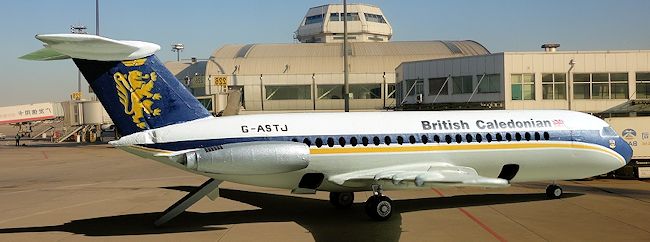 Mergers
and acquisitions were mooted by various airlines. British Airways won in the
end, and on 14 April 1988 British Caledonian was no more.
Mergers
and acquisitions were mooted by various airlines. British Airways won in the
end, and on 14 April 1988 British Caledonian was no more.
Its 13 BAC-111 short-haul passenger jets were sent out to regional routes,
and replaced by Boeing 737-200s for operations out of London Gatwick.
The BAC-111 was a notoriously noisy jet (as a kid in a different city I
lived under their flightpath). It came into service after the French
Caravelle and was quite successful. 244 were made and many served into the
1990s until their noise was just too noisy.
You can read a preview
right here on MM:
In a nutshell, it's classic "good Airfix". Raised panel lines, yes, but
nicely done. A few details like cabin and cargo doors you can pose open if
you like. Otherwise fairly si mple
but appropriate for the small scale, given the kit's age.
mple
but appropriate for the small scale, given the kit's age.
It comes with open windows but no clear plastic to put in there. You need to
either fill them up, noting that the kit's decals don't have windows on
them, or do as the instructions suggest and make windows out of some clear
substance after punching lots of holes in the decals. To be honest, that's a
pretty dumb solution - either have decals with windows, or decals with holes
where the windows go, right? At least the kit has a little dedicated
holepunch.
Decal options are the British Caledonian you see here, or an Aer Lingus (the
Irish airline).
A bit of weight up front is all you need before building this - there is no
cockpit. If you plan to pose the doors open, some interior bulkheads might
be worthwhile, or at least a floor (though of course, I didn't bother). When
I assembled this I was planning on doing the doors closed, but later (like,
two years later, when I got back to building this one before it went back
onto the Shelf of Doom) I decided to pose them open. I'm not sure it matters
that the interior isn't blanked off, but if I was doing it again I might
make the effort (especially, I realise now, as I look at the photos).
Fit is pretty good. I had a bit of a mess at the top fuselage seam, through
no fault of the kit's, but after a decent chunk of sanding, things were ok.
The engines needed a decent amount of sanding too.
The internet abounds with lists of this kit's inaccuracies, but most of them
didn't worry me too much. One simple, easy mod you can do to make this a bit
more accurate is to add a wing fence inboard and delete the outboard one
(keep the blob on the trailing edge that is the thing that operates the
control surfaces). Just outboard of the innermost of those blobs, you want
to make a pretty decent sized wing fence, as I have tried to do on this
model. Google has more than enough photos. This is a very obvi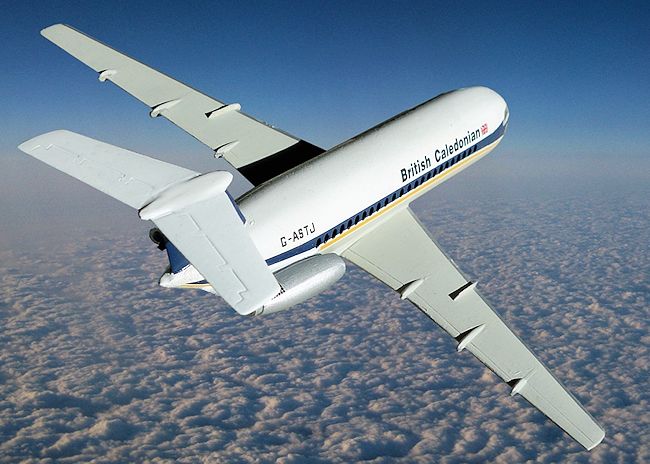 ous
inaccuracy, and an easy enough mod, so I did it. This goes some way to
shutting up the former BAC-111 mechanics or similar internet busy bodies who
will foam at the mouth if you dare post a picture of your un-modded build
somewhere on the web.
ous
inaccuracy, and an easy enough mod, so I did it. This goes some way to
shutting up the former BAC-111 mechanics or similar internet busy bodies who
will foam at the mouth if you dare post a picture of your un-modded build
somewhere on the web.
The other thing you might want to try is sharpening the nose cone. The
Airfix kit depicts the very earliest model of the BAC 1-11, but almost all
the production run had a pointier nose. I decided against this for reasons
that will become clear as you read further.
The cargo doors appear to have popped out, then slid down under the
fuselage, leaving easy access to the cargo hold. Have a look at the picture
linked below. I simply glued the doors in place on the bottom of the hull.
Meanwhile, the main passenger door goes on facing outwards, as though it
simply slides to the left as you open it. And the air stair at the end
operates in an obvious way.
The engines don't fit perfectly to the fuselage. Do some remedial work if
you like, though I wasn't too fussed.
I had a bit of difficulty getting the canopy glass into place. I ended up
trimming here and there with a knife, but in the process I scratched the
decals with my fingernail.
Man, I really messed this thing up. I tried a few different greys for the
underside and wings, decided I didn't like them, and then tried another one.
I forgot the golden rule that Tamiya acrylics and Gunze enamels aren't
friends. I made an unholy mess and in the end I had to sand the entire thing
back to the bare plastic.
So. Over. Sanding.
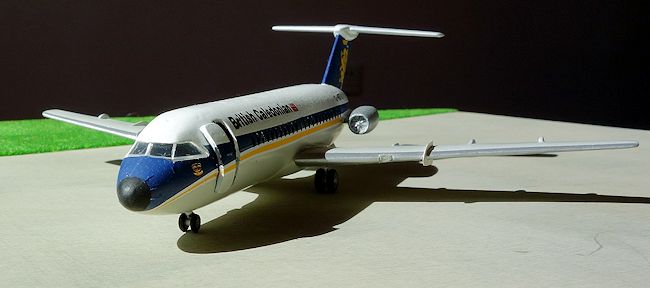 That's
why I chose not to sharpen the nose cone. More sanding? Screw that!
That's
why I chose not to sharpen the nose cone. More sanding? Screw that!
This is why my model languished on the Shelf of Doom for, like, forever.
In the end the colours I went for were gloss white (Tamiya X-2) over Vallejo
71.883 silver grey. I considered (ie applied then sanded off) Light Gull
Grey too, but went with this instead. Look at the pictures linked under
references and make up your own mind (some are of the -500 model, not the
-200, but the scheme's the same). I think the Vallejo colour is a little
lighter than the Light Gull Grey. The wing leading edges are some kind of
silver colour so I went with Tamiya XF-16, my go-to aluminium paint. The
blue is Tamiya XF-8 "Flat Blue". I used a matt blue because the decals are
very flat, and this colour was a pretty close match.
All but the white was brush painted; the white came from a spray can (after
some aborted efforts at brushpainting it which were also sanded back).
You don't need to be too careful with the demarcation between grey and
white, because the decal (at least on the British Caledonian version) takes
care of that. You just need to work out roughly where the line should be. I
trimmed off the relevant decals and put them on the side of the plane, then
traced a pencil line where they ended, and made sure I painted just a bit
inside of it. That worked pretty well.
Surprisingly for an Airfix kit of this era, the decals are actually usable.
They respond well to Mr Mark Softer which you'll need to get the nosecone
area decals to smooth out. Mine weren't perfect but pretty good. The Union
Jack on the airline name for the fuselage sides is out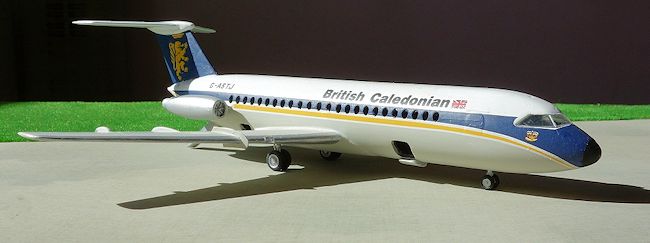 of register but it isn't too appalling. Sadly, the tail emblem is the yellow
design only, and doesn't come with the blue background. This means you need
to paint that and do your best to make it match the blue colour on the
fuselage stripe. Annoying!
of register but it isn't too appalling. Sadly, the tail emblem is the yellow
design only, and doesn't come with the blue background. This means you need
to paint that and do your best to make it match the blue colour on the
fuselage stripe. Annoying!
There are some smaller decals, but apart from the registration number and a
smaller one near the nose, I only used the black grids that are meant to
represent part of the engine exhaust (something to do with reverse thrust I
think). The smaller little labels I just left off. The decals do not include
the prominent lines for the main and emergency doors. This is especially
annoying as they are so obvious on the real thing. If you decide to add them
somehow, be sure to add only one overwing exit per side, not two. British
Caledonian flew the shorter and longer variants of the BAC 1-11; this kit is
the shorter one with just one overwing escape route.
One last thing to note is that the decals were very fragile. I scratched the
B in British on the left side as I was trying to install the cockpit window.
I had to touch it up with a marker pen
As someone said, it's the only injection moulded BAC 1-11 there is. And I'd say
it's the only one there's ever going to be. Even right out of the box it looks
pretty close to me, but with the simple wing fence mod, and maybe sharpening the
nose, it's as good as "dead on" as you can get - you'll convince all but the
most detail-oriented 111 experts. In 1/144 it is an entirely manageable size,
too, about the size of an smaller 1/72 jet fighter. I like the option to have
the passenger doors and cargo doors open, too. You could probably make a neat
diorama with a few figures and perhaps a vehicle or two. Recommended for all but
beginners, despite all the trouble I had, which was entirely my own fault.
This pic is of the actual aircraft in this kit:
http://www.al-airliners.be/b-c/bcal/br1-11-500.jpg
Pic of cargo door alignment:
http://www.british-caledonian.com/images/B111-4%20G-AWWX.jpg
http://www.al-airliners.be/b-c/bcal/br1-11-300.jpg
http://img.planespotters.net/photo/242000/original/PlanespottersNet_242221.jpg
http://upload.wikimedia.org/wikipedia/commons/1/17/British_Caledonian_BAC_111-201AC.jpg
http://img.planespotters.net/photo/242000/original/PlanespottersNet_242223.jpg
https://www.flickr.com/photos/emdjt42/3247702407/
Richard F
March 2015
If you would like your product reviewed fairly and fairly quickly, please
contact
the editor
or see other details in the
Note to
Contributors.
Back to the Main Page
Back to the Review Index Page


 British
Caledonian was a private airline that grew from a charter operation to a
fully competitive scheduled airline in the 1970s. By 78 and 79, when I
became aware of it from the old man's business trips, it was really hitting
its stride. New routes were opening up and its investment in widebody jets
saw its profits at nearly 10 million pounds by 1980.
British
Caledonian was a private airline that grew from a charter operation to a
fully competitive scheduled airline in the 1970s. By 78 and 79, when I
became aware of it from the old man's business trips, it was really hitting
its stride. New routes were opening up and its investment in widebody jets
saw its profits at nearly 10 million pounds by 1980. Mergers
and acquisitions were mooted by various airlines. British Airways won in the
end, and on 14 April 1988 British Caledonian was no more.
Mergers
and acquisitions were mooted by various airlines. British Airways won in the
end, and on 14 April 1988 British Caledonian was no more. mple
but appropriate for the small scale, given the kit's age.
mple
but appropriate for the small scale, given the kit's age. ous
inaccuracy, and an easy enough mod, so I did it. This goes some way to
shutting up the former BAC-111 mechanics or similar internet busy bodies who
will foam at the mouth if you dare post a picture of your un-modded build
somewhere on the web.
ous
inaccuracy, and an easy enough mod, so I did it. This goes some way to
shutting up the former BAC-111 mechanics or similar internet busy bodies who
will foam at the mouth if you dare post a picture of your un-modded build
somewhere on the web. That's
why I chose not to sharpen the nose cone. More sanding? Screw that!
That's
why I chose not to sharpen the nose cone. More sanding? Screw that! of register but it isn't too appalling. Sadly, the tail emblem is the yellow
design only, and doesn't come with the blue background. This means you need
to paint that and do your best to make it match the blue colour on the
fuselage stripe. Annoying!
of register but it isn't too appalling. Sadly, the tail emblem is the yellow
design only, and doesn't come with the blue background. This means you need
to paint that and do your best to make it match the blue colour on the
fuselage stripe. Annoying!